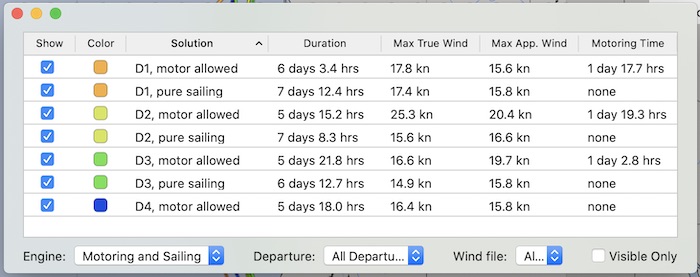Departure planning is the process of choosing the best time to leave for a passage. There may be many criteria used when planning your departures. You may want the shortest passage, or the most comfortable. Sailors who want to avoid using their engines may prefer a departure which minimizes the motoring time. If you are at sea, hove to in a gale, you can use the departure planning feature to help plan when to start sailing again.
LuckGrib’s weather routing system has many tools available to help you evaluate and understand the solutions it generates. In order to evaluate different departure times, you tell the system how many departures you want to generate, and the time interval between them. (See the section in the user manual for additional detail.)
In this example, the sailboat is leaving Neah Bay and sailing to San Francisco:


Four departures were generated (D1, D2, D3, D4) each 24 hours apart. The vessel is allowed to motor, and the system was asked to generate variations for each departure, one which was allowed to motor and one which only sails.
There is much more information available to evaluate the departures than is shown above, but even this limited information is interesting.
The first days departure, D1, either needs to motor for a day and a half to arrive, or sail for around 7 ½ days. The second days departure is similar, although the motoring variant of the solution arrives in around 5 ½ days.
The fourth departure is the most interesting, as it is the second fastest overall, does not need to motor at all, and the maximum winds encountered are very moderate.
Given that report, I would be inclined to not use the first departure and delay the decision a day, re-running this exercise the next day, hoping that the fourth days departure continues to look promising.
Of course, if you had to leave for some reason, the first days departure looks safe enough. However, with a little patience it appears that a pure sailing passage may be available if you wait three days. Yay!
Combining departure planning with other variations.
Recall from the discussion on ensemble models, that it is possible to have the weather routing solver generate many solutions, according to how many wind data fields there are in the GRIB file. You can combine this with departure planning to generate an enormous number of solutions.
For fun, you should try using departure planning along with a full GEFS wind ensemble model. That model has 32 wind fields. If you generate 4 departures, you will have 128 solutions. If you want the motoring/no-motoring variants as well, then you may get up to 256 solutions. It starts to be a lot.
There are tools to help with this complexity. Or you may choose to use a subset of the wind parameters for departure planning and then the full ensemble to study one particular departure. It’s up to you how you choose to work with the system.